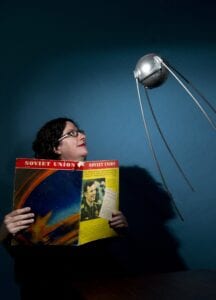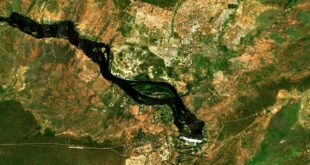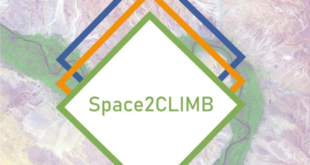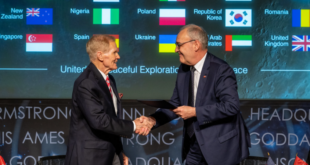by Chiara Moenter

During this week’s SpaceCafé, SpaceWatch.Global publisher Torsten Kriening caught up with space archaeologist and associate professor at Flinders University. Prof. Dr. Alice Gorman.
Alice Gorman is Associate Professor at Flinders University, and an internationally recognised leader in the field of space archaeology. Her research focuses on the archaeology and heritage of space exploration, including space junk, planetary landing sites, off-earth mining, rocket launch pads and antennas. She is a Senior Member of the American Institute of Aeronautics and Astronautics and a former Deputy Chair of the Space Industry Association of Australia. Her award-winning book Dr Space Junk vs the Universe: Archaeology and the Future was published in 2019.
This week, she and Torsten talk about the space archaeology, the Moon, lunar poetry and Game of Thrones.
Space archaeology explained
Although the term archaeology is often linked to the study of ancient things it has a strong link to space, even if this field appears to be rather futuristic.
“Basically, space archaeology is the study of all of the objects and the places that are associated with the human movement into space. So, this means launch sites, tracking stations, antennas, research, and development locations on the surface of the Earth, means everything that is in Earth orbit right now, all of those rocket bodies and space stations and satellites and space junk, all of the landing sites on planetary bodies throughout the solar system, and deep space probes.”
Space archaeology seeks to study all the material things that humans have left behind in the solar system, helping to learn more about human behaviour.
There is also another kind of space archaeology which uses space tools such as satellites, providing Earth Observation imagery to look at ancient sites on Earth.
“So, those kinds of archaeologists are using the satellites, whereas I’m studying the satellites.”
What does Game of Thrones have to do with it?
When discussing if the moon should be considered dead or alive, a quote from the fantasy series Game of Thrones found its way into the conversation: “What is dead can never die”.
Alive pointed out the paradox “if something’s already dead, how can it die again?” and then drew the connection to many parts of space that are considered dead and the questions this raises.
“There’s a whole lot of things in space, that are treated as if they’re dead. But you could argue that there are many, many shades of existence between, like living as a kind of a biological sentient being, as we are right now. And, and being an asteroid, or a moon, or a spacecraft that’s not currently being used and as technically defined as junk.”
Alice’s primary interest in the moon is the cultural heritage aspects of all of the human landing places, especially viewing the moon as a place. There has been a very rapid development of interest in the moon in the last few years.
“Since I started working on the archaeology of the moon, of course, you know, nothing was happening for a long, long time. And now suddenly, everyone’s going to the moon, they’re going to extract resources for, you know, in situ resource utilization, they’re planning surface missions, they’re planning habitats. They’re thinking about mining the moon’s resources and using them to get to Mars. And this has all happened, like, in the last five years.”
The explanation for this rapid development could be linked to people stating that the moon is dead and therefore, these developments cannot cause any harm to life, as there is no such life existing. However, this is a larger debate. According to Alice the moon is not dead.
“The moon is seismically active. We’re learning as more and more studies are being done. The moon has active water cycles. Sure, they’re not based around oceans on rain, like they are on earth. They’re based on, more or less wet interactions with cosmic rays and solar flares, and micrometeorites and all that kind of stuff. But we know that water forms and dissipates and reforms on the moon. So, there’s so much we don’t know. And the moon is engaged. It is vitally engaged with the Earth, look at the tides. And with the rest of the solar system, it’s in a dynamic interchange with the cosmos. So, is this really dead? I would argue not.”
Surprisingly, Alice is often met with anger when voicing this opinion. She links this back to people not wanting to feel a moral obligation towards the moon, which would be a consequence of it being alive. Another reason for this reaction, Alice links back to the misconception of environmental consciousness being a feminine field.
Moon poetry
Alice states that moon poetry opens doors with new and richer language in order for us to describe and talk about the moon.
“I think this means the engagement of a whole range of different kinds of people with different approaches.”
There were two poems Alice shared with us, one by the Australian poet Ceridwen Dovey, and by the artist Christine Reuter (tycho girl).
“So, I am made of much more disturbing stuff, seas of death. Bays of lunacy, craters of indifference to human time” – Ceridwen Dovey, Moonrise
“So, this is the palm-crescent home. You’ve only been away a week, and yet you stare at the terminator on your present home. And a shadow fall across a place you know.” – Christine Reuter
Alice poignantly describes that these poems with their intimate wordings can create a longing for a place that we don’t yet call home, yet.
Into the shadows
“Those shadows are a sign. They’re a sign of human presence. So, for me, the shadows cast by human materials on the moon just have so many levels of complexity and meaning.”
Shadows were one of the first things Apollo 11 astronaut Neil Armstrong mentioned when he stepped onto the surface of the moon. “It’s quite dark here in the shadow [of the lunar module] and a little hard for me to see that I have good footing,” he radioed to Earth.
10 years ago, NASA created a set of guidelines to recommend to people conducting activities on the lunar surface to protect these shadow sites. And part of that was creating buffer zones around them sort of like Exclusion Zones, you can’t go inside these zones, or you risk stirring up a lot of dust and damaging them.
“Then it occurred to me that some parts of the site, in fact, are not tangible. Because the shadow is caused by the landing modules, the experiment packages, you know, the abandoned rovers, are a thing in themselves a cultural product in themselves that might have heritage significance.”
Looking at permanently shadowed regions, they don’t just hold a natural heritage value and offer up much valuable data. There is among them also a cultural heritage site that is very meaningful for people on Earth. This can be linked to the memorial to Eugene Shoemaker, American astrophysicist and geologist and the only person to be buried on the moon.
Declaration of the Rights of the moon
The Declaration of the Rights of the moon arose out of a series of discussions between a team of lawyers, and space enthusiastic professionals.
“The idea came up that we needed a Declaration of the Rights of the moon because no such declaration existed, it seemed like such a simple thing. Just to set out what rights does the moon have.”
Over the span of a year, they knotted out the principles we thought were important.
“One thing we did think was incredibly important was that, really, the stakeholders in the future of the moon are the entire population of Earth. So really, everybody should have a say.”
The purpose of this declaration was getting the ideas on paper, have points to counterbalance to the current discussions and bring another perspective to the table. Two of the key rights Alice saw as important to mention centre around the right of the moon to maintain ecological integrity, and the right to remain forever a peaceful celestial entity unmad by human conflict and warfare.
To listen to Alice Gorman’s insights on space archaeology and the Moon and her recommendations for lunar poetry, you can watch the full program here:
Chiara Moenter is the event coordinator of SpaceWatch.Global and the co-founder of “SDG18: Space for All”. Currently, she is doing her masters in Sustainability Science at Maastricht University.





